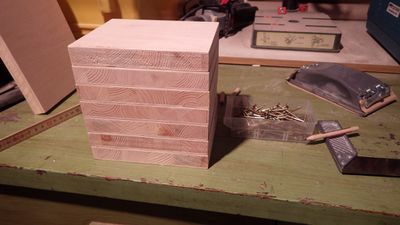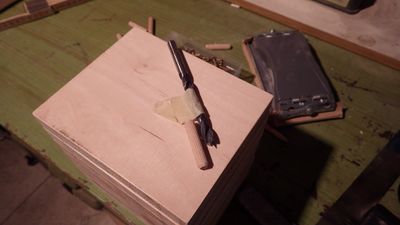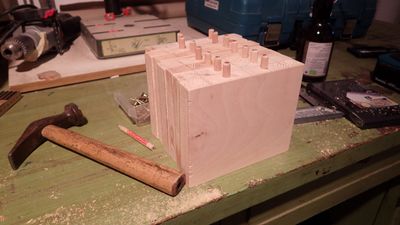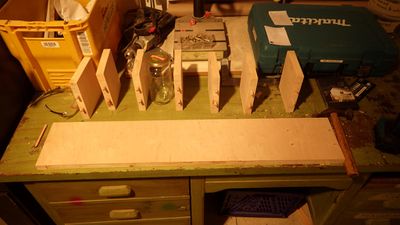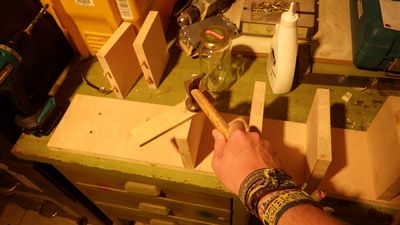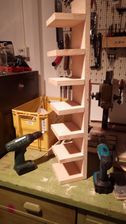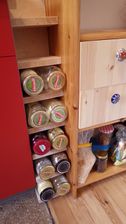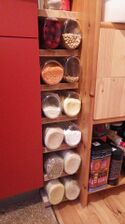Project:Jar Jar Shelf: Difference between revisions
m Category:Quick Projects |
m Text replacement - "[[Circular Saw|circular" to "[[Handheld Circular Saw|handheld circular" |
||
| Line 6: | Line 6: | ||
|initiator=[[User:Lukas|Lukas]] | |initiator=[[User:Lukas|Lukas]] | ||
|materials=[[blockboard]], [[Dowel Pegss|dowel pegs]],<br>[[screws]], [[Brackets|bracket]] | |materials=[[blockboard]], [[Dowel Pegss|dowel pegs]],<br>[[screws]], [[Brackets|bracket]] | ||
|tools=[[Circular Saw|circular saw]], [[Chop Saw|chop saw]],<br>[[sandpaper]], [[Cordless Drill|cordless drill]] | |tools=[[Handheld Circular Saw|handheld circular saw]], [[Chop Saw|chop saw]],<br>[[sandpaper]], [[Cordless Drill|cordless drill]] | ||
|cost=10 € for materials | |cost=10 € for materials | ||
}} | }} | ||
| Line 18: | Line 18: | ||
== Making == | == Making == | ||
One 85{{x}}15.5 cm and seven 12.5{{x}}15.5 cm boards were cut using a [[Circular Saw|circular saw]] and a [[Chop Saw|chop saw]] (the proper tool would have been a [[Table Saw|table saw]] to which I did not have access at the time). | One 85{{x}}15.5 cm and seven 12.5{{x}}15.5 cm boards were cut using a [[Handheld Circular Saw|handheld circular saw]] and a [[Chop Saw|chop saw]] (the proper tool would have been a [[Table Saw|table saw]] to which I did not have access at the time). | ||
After some good [[sanding]] from all sides (120 grit), the small boards where arranged according to the would-be fronts so that darker and lighter boards alternated. The back sides where drilled with an 8 mm [[Wood Drill Bits|wood drill bit]] to receive two [[Dowel Pegs|dowel pegs]] each. These were entered into matching holes in the larger board after applying some [[Wood Glue|wood glue]] to the side of the small board. Two 4{{x}}50 mm [[Wood Screws|wood screws]] per board made sure the glue received enough pressure and the connections some extra stability. 3 mm [[Countersinks|countersunk]] pilot holes were drilled to ensure a nice fit of these screws. | After some good [[sanding]] from all sides (120 grit), the small boards where arranged according to the would-be fronts so that darker and lighter boards alternated. The back sides where drilled with an 8 mm [[Wood Drill Bits|wood drill bit]] to receive two [[Dowel Pegs|dowel pegs]] each. These were entered into matching holes in the larger board after applying some [[Wood Glue|wood glue]] to the side of the small board. Two 4{{x}}50 mm [[Wood Screws|wood screws]] per board made sure the glue received enough pressure and the connections some extra stability. 3 mm [[Countersinks|countersunk]] pilot holes were drilled to ensure a nice fit of these screws. | ||
Latest revision as of 09:24, 20 September 2022
| ProjectInfoBox Jar Jar Shelf | |
|---|---|
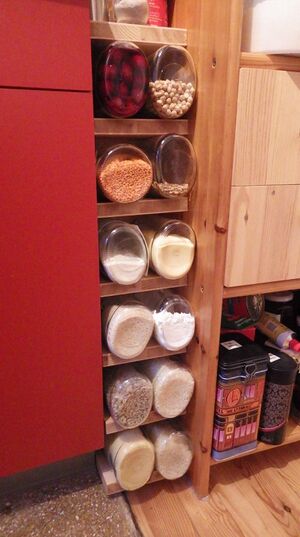
| |
| Status: | finished |
| Release Date: | July 2016 |
| Initiator: | Lukas |
| Materials Used: | blockboard, dowel pegs, screws, bracket |
| Tools Used: | handheld circular saw, chop saw, sandpaper, cordless drill |
| Approx. Cost: | 10 € for materials |
This is a shelf for effectively storing those 720 g jars, e.g. as used by "Odenwald" for fruit preserves, in a small space between kitchen cabinets. It consists of several instances of a shelf and two jars - hence the name.
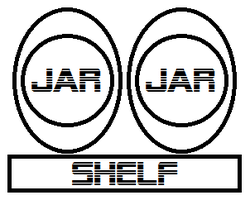
Idea
The maximum size was basically dictated by the already existing kitchen furniture and the jars that are great for storing lots of cooking supplies that are sold in flimsy plastic bags, e.g. lentils or semola. Placing the jars on their sides maximizes capacity as well as ease of access (once the lids are labeled). The shelf is mounted at an angle so the jars slide - if at all - only backwards and do not fall down.
Blockboard was chosen as a material as it looks pretty cool when cut in the right orientation and I had some appropriately sized leftovers from building bigger shelves.
Making
One 85 × 15.5 cm and seven 12.5 × 15.5 cm boards were cut using a handheld circular saw and a chop saw (the proper tool would have been a table saw to which I did not have access at the time).
After some good sanding from all sides (120 grit), the small boards where arranged according to the would-be fronts so that darker and lighter boards alternated. The back sides where drilled with an 8 mm wood drill bit to receive two dowel pegs each. These were entered into matching holes in the larger board after applying some wood glue to the side of the small board. Two 4 × 50 mm wood screws per board made sure the glue received enough pressure and the connections some extra stability. 3 mm countersunk pilot holes were drilled to ensure a nice fit of these screws.
Just a bit more sanding and done!
- assembly steps
-
small pieces of blockboard waiting for assembly
-
wood drill bit marked with masking tape to see how deep to drill
-
small boards with wooden dowels and additional markings for screws
-
all boards aligned for assembly, with a jar for a last check of measurements
-
place a piece of scrap wood on your workpiece when hammering to keep it clean
-
fully assembled shelf with cordless drills (one for drilling, one for screwing)
-
installed in Lukas' kitchen
-
putting the glasses in lid-first gives a nice overview of their contents!
Mounting
The shelf was mounted at an angle of approx. 20 degrees. The base rests on the floor and a single bracket attached to the side of the neighboring kitchen shelf is sufficient to maintain this position. This step would have been quicker if I'd attached the bracket before the glue-up or had an angled bit holder back then...
Further Steps
The jars (sides or bottoms) may eventually be laser engraved with the names of the contents and/or basic recipes.
Things Learned
- the design is not adapted for comfortable bike transportation
- everything would have been a lot easier with dowel centers and a table saw which we have now, but not when I made it!
